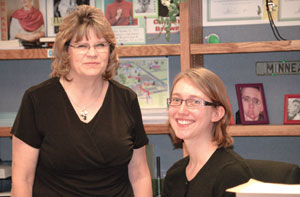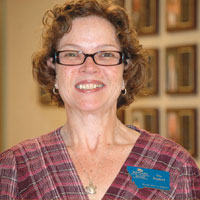University Communications and Marketing
Personal connections, accessibility noted at MSU Billings on 20th anniversary of landmark disabilities act
July 26, 2010
Contacts:
Dan Carter, University Relations, 657-2269
Disability Support Services, Montana Center on Disabilities integral part of university’s culture
MSU BILLINGS NEWS SERVICES — It’s one thing to talk about the personal empowerment gained by social legislation. It’s another to see the benefits up close. And it’s quite another to commit to continued progress.
Jill Stout embodies all three.

And as the Americans with Disabilities Act marked its 20th anniversary on Monday, Stout and some of her colleagues at Montana State University Billings said they look forward to more accessibility gains for the disabled in the coming years.
“It was mostly a huge attitude change,” said Stout, a program assistant with Disabilities Support Services at MSU Billings. “It went from thinking about charity to understanding these people have rights and we have an obligation to provide access to them.”
Stout’s passion for the topic of disability support, services and accessibility is more than professional. It’s intensely personal.
She was an active fourth-grader in Minnesota when the law was passed. Her brother, Aaron, who has limited sight and speech abilities and communicates via sign language, was just four years old at the time. Based on the prevailing attitudes of ability segregation at that time, Stout’s mother worked tirelessly for passage of the law.
“It was a pretty big deal in our house,” she said.
She still remembers a poster from 1980 that embodied the push for social justice for Americans who found themselves living with mobility, hearing or sight disabilities. It showed a man in a wheelchair holding a sign that read “I can’t even get to the back of the bus.”
The impacts of the Americans with Disabilities Act are clear today. The law made possible public restroom grab bars, wheelchair-accessible buildings and parking, sign-language interpreters at speeches, to and anti-discrimination hiring policies possible. Civil rights were extended to an entire group of Americans — 41.3 million at last count — for the first time.
For potential college students, it turned the focus from disabilities to educational opportunities and potential success.
Fast forward to 2010, and Stout brings her understanding of disability issues to work with her every day. She is one of four full-time staff who works at the MSU Billings main campus and the West End College of Technology to bring services to students. More than 160 students were registered for services through DSS last spring semester and more are likely this coming fall.
Many of those students need textbooks translated into audio files or support in addressing learning disabilities.
Eight of those students are hearing impaired and need some accommodations, said Cathy Copeland, the lead sign language interpreter at MSU Billings. Copeland has two other part-time interpreters who worked with her last to provide sign language or captioning services for hard-of-hearing students.
Copeland, who has been associated with MSU Billings for 16 years, said providing captions to video or audio files, is quickly becoming a bigger concern. She and others in the DSS office work to encourage MSUB faculty and staff to think about becoming more inclusive when making curriculum decisions. Including a YouTube video in a class presentation may be an effective teaching tool, Copeland said, but for a student who is hard of hearing, that learning opportunity is lost.
“If captioning is included in every video and it’s not an afterthought, then everybody benefits,” she said.
Copeland and Stout work with DSS Director Trudy Carey and COT Program Coordinator Jennifer Woegens to keep pace with student needs. One of the biggest is making sure those with sight impairments are able to have MP3 files of their textbooks.
Not too many years ago, textbooks that didn’t have an audio component would be read into tape recorders by Copeland and others. Advancements in technology have enabled DSS to electronically scan books computers where software will turn the files into text and then eventually into an audio file. A chart about the size of a coffee shop concert poster shows the audio textbook needs of a host of students enrolled this fall.
It’s a summer project that entails checking history book maps, medical text charts and math equations. That process takes time to edit and review the files, but allows all students access to MSU Billings educational programs regardless of physical abilities.
Seeing beyond disabilities has actually been a part of MSU Billings for more than 50 years.

In 1947, the Montana Center on Disabilities began operating as part of the public service mission of what was then Eastern Montana College. Serving children with Cerebral Palsy and their families, it was known as the Montana Center for Handicapped Children for about 30 years and the role eventually expanded to working children with all types of disabilities.
After children with disabilities were integrated into their neighborhood schools in 1986, the center matured into a service entity to provide education and support for those working to create a fully inclusive society.
Tina Hoagland, an audiologist and MCD project director who has been with the center since 1985, said the changes brought about by the Americans with Disabilities Act have ensured that children and adults with disabilities are not left behind. Among other things, the center provides direct service programs to youth with disabilities that focus on career planning and leadership skills and professional development to educators and service providers.
The goal, Hoagland said, is to make certain all students and adults have equal opportunity to succeed.
For Stout, it all comes back to her brother, whose smiling face peers over her shoulder as she works at her desk.
“It (the ADA) recognized the personhood of someone with disabilities,” she said. “It’s been affirming to be a part of social justice, embracing another form of diversity to accept people as people.”
The next big step in accessibility will be toward “universal design” where the learning environment, living environment and curriculum are accessible to and used by everyone, not just those with disabilities. Curb cuts and ramps installed for wheelchairs are now an embedded part of society. There is no reason that can’t be embodied in every aspect of society, she and Copeland said.
“We’ve made strides,” Copeland said. “But not big enough.”
----
For more information about Disability Support Services at MSU Billings, call 657-2283.
For more information on the services provided by the Montana Center on Disabilities,
call 657-2312 or go to www.msubillings.edu/mtcd/
PHOTOS ABOVE: 1) Cathy Copeland, interpreter, and Jill Stout, program assistant, assist more than 160 students a semester through the Disability Support Services office at Montana State University Billings;. 2) Tina Hoagland has been associated with the Montana Center on Disabilities since 1985. The Montana Center is a public service arm of MSU Billings. www.msubillings.edu/mtcd/
